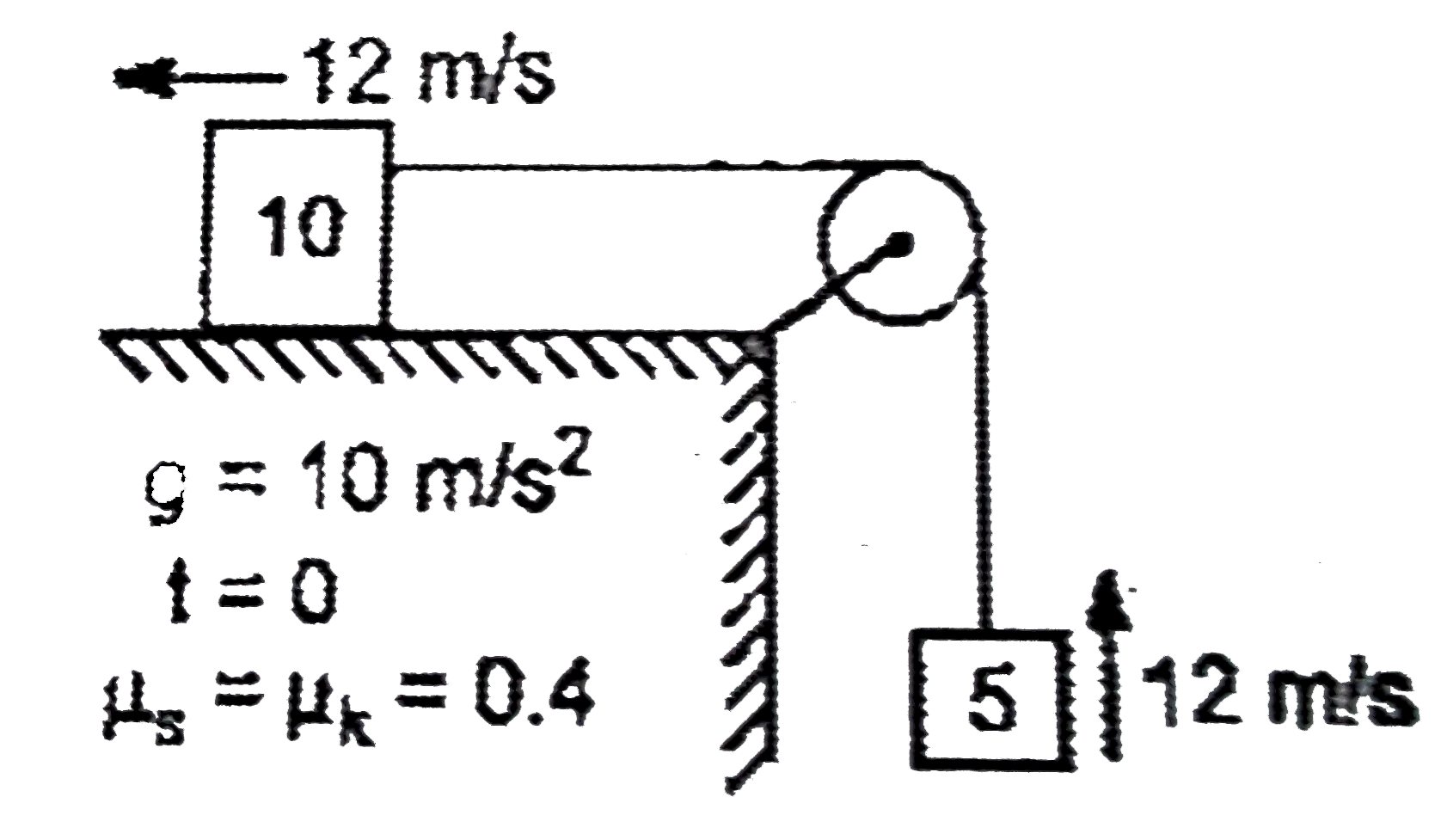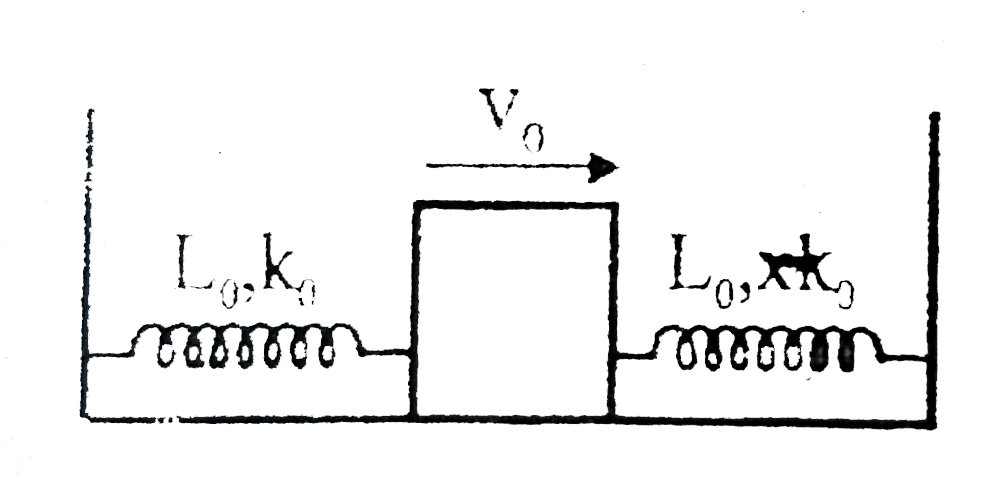The undamped system in Fig.consists of a block mass m = 4 kg and a spring spring constant k = 1 N/m. The block is subjected to a force Ft. The initial conditions x0 = x0 = 1m ˙x0 = 0 and the responseto the excitation are given. Heret0 = 1 s T = 5 s and t − T 0 = 0 for t TCalculate the force Ft.
First we calculate the force F for t T . Then t − T0 = 1 and the response follows asIntroduction into the equation of motion yields
Related Solutions
Two blocks A and B, each of mass m, are connected by a spring of force constant K. Initially, the spring is in its natural length. A horizontal constant force F starts acting on block A at time t=0 and at time t , the extension in the spring is seen to be l . What is the displacement of the block A in time t ?
View SolutionThe spring block system lies on a smooth horizontal surface. The free endof the spring is being pulled towards right with constant speed v_(0) = 2m//s . At t = 0 sec , the spring of constant k = 100 N//cm is unsttretched and the block has a speed 1 m//s to left. The maximum extension of the spring is. .
View SolutionThe spring block system lies on a smooth horizontal surface. The free end of the spring is being pulled towards right with constant speed v_(0) = 2m//s . At t = 0 sec , the spring of constant k = 100 N//cm is unstretched and the block has a speed 1 m//s to left. The maximum extension of the spring is. .
View SolutionThe spring block system lies on a smooth horizontal surface. The free end of the spring is being pulled towards right with constant speed v_(0) = 2m//s . At t = 0 sec , the spring of constant k = 100 N//cm is unstretched and the block has a speed 1 m//s to left. The maximum extension of the spring is. .
View SolutionA block of mass 1 kg is connected with a massless spring of force constant 100 N/m. At t = 0, a constant force F = 10 N is applied on the block. The spring is in its natural length at t = 0. The speed of particle at x = 6 cm from mean position is :
View SolutionA block of mass 1 kg is connected with a massless spring of force constant 100 N"/"m . At t=0, a constant force F= 10 N is applied on the block. The spring is in its natural length at t=0. The speed of particle at x=6 cm from mean position is :
View SolutionA block of mass 1 kg is connected with a massless spring of force constant 100 N"/"m . At t=0, a constant force F= 10 N is applied on the block. The spring is in its natural length at t=0. The speed of particle at x=6 cm from mean position is :
View SolutionA block whose mass m is 680g is fastened to a spring whose spring constant k is 65N/m. The block is pulled a distance x=11cm from its equilibrium position at x=0 on a frictionless surface and released from rest at t= 0.
What is the displacement function x(t) for the spring block system?View SolutionIn the arrangement shwon, initially both springs are in their natural length l_(0) . The left spring has force constant k_(0)=2N//m and the force constant of the right spring varies as k=k_(0)x , where x is its compression. The mass of the block is 10/3 kg. At time t=0, the block is given a right ward velocity v_(0)=2 m/s. Both the springs are massless. The distance covered (approximately) by the block before it comes to instantaneous rest for the first time is
View SolutionA block of mass 1 kg is moving on the -axis. A force F acting on the block is shown. Velocity of the block at time t= 2 s -3 m s^(-1) Is. What is the speed of the block at time t= 4 s?
View Solution2 किग्रा द्रव्यमान के किसी गुटके को एक स्प्रिंग से जोड़ा गया है। स्प्रिंग का स्प्रिंग नियतांक 50 न्यूटन/मीटर है। गुटके को x = 0 पर इसकी साम्यावस्था से t = 0 पर विरामावस्था से घर्षण रहित क्षैतिज पृष्ठ पर 5 सेमी दूरी तक खींचा जाता है। किसी समय t पर गुटके का विस्थापन ज्ञात कीजिए।
View SolutionBlocks are given velocities as shown at , find velocity and position of 10 kg block at and .
 View Solution
View SolutionAs shown in the figure, initially both th springs are in normal length . At t=0, the block is given a rightward velocity . The mass of the block is . How much distance does th block cover before it comes to rest for the first time? (The spring constant of the left spring is and that of the right spring is not constant and varies as , where x is the compression in the spring)
 View Solution
View SolutionAs shown in the figure, initially both th springs are in normal length . At t=0, the block is given a rightward velocity . The mass of the block is . How much distance does th block cover before it comes to rest for the first time? (The spring constant of the left spring is and that of the right spring is not constant and varies as , where x is the compression in the spring)
 View Solution
View SolutionAs shown in the figure, initially both th springs are in normal length . At t=0, the block is given a rightward velocity . The mass of the block is . How much distance does th block cover before it comes to rest for the first time? (The spring constant of the left spring is and that of the right spring is not constant and varies as , where x is the compression in the spring)
 View Solution
View SolutionIn the arrangement shwon, initially both springs are in their natural length l_(0) . The left spring has force constnat k_(0)=2N//m and the force constant of the right spring varies as k=k_(0)x , where x is its compression. The mass of the block is 10/3 kg. At time t=0, the block is given a right ward velocity v_(0)=2 m/s. Both the springs are massless. When the blcok comes to instantaneous rest th energy stored in the left spring is
View SolutionIn a horizontal spring-block system force constant of spring is k = 16N/m, mass of the block is 1 kg. Maximum kinetic energy of the block is 8J. Then
View SolutionIn a horizontal spring-block system force constant of spring is k = 16N/m, mass of the block is 1 kg. Maximum kinetic energy of the block is 8J. Then
View SolutionThe period of oscillation of a mass M suspended from a spring of spring constant K is T. the time period of oscillation of combined blocks is
View SolutionA block of mass 1kg is connected with a massless spring of force constant 100 N//m . At t = 0 , a constant force F = 10N is applied on the block. The spring is in its netural length at t = 0 . The speed of particel at x = 6cm form mean position is
View Solution
